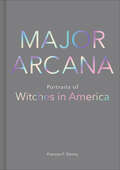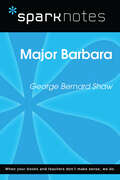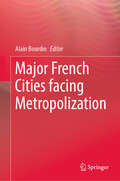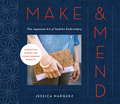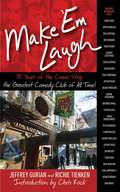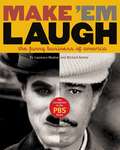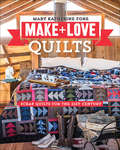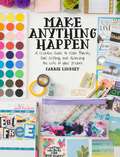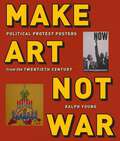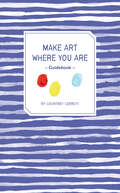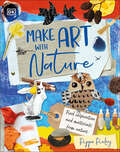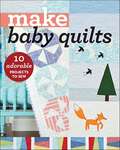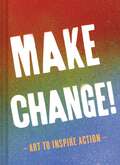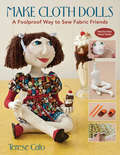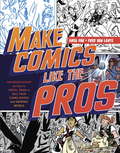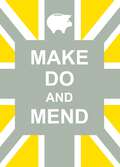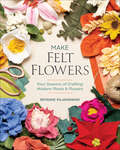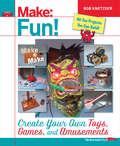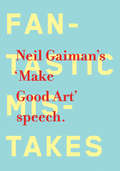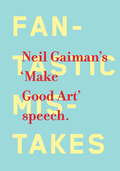- Table View
- List View
Major Arcana: Portraits of Witches in America
by Frances DennyBased on her critically acclaimed exhibition, Major Arcana collects the work of photographer Frances F. Denny, who traveled around the U.S. photographing and interviewing a diverse group of people who identify as witches.This book is an exploration of contemporary witchery told through striking photographs and short, inspiring essays written by the &“Terry Gross of witches,&” Pam Grossman, and the subjects themselves. From occultists and Neo-pagans, to herbalists and Wiccan High Priestesses, Denny&’s portraits capture the face of modern American witchcraft and challenge our assumptions about who and what a witch really is.
Major Barbara (SparkNotes Literature Guide Series)
by SparkNotesMajor Barbara (SparkNotes Literature Guide) by George Bernard Shaw Making the reading experience fun! Created by Harvard students for students everywhere, SparkNotes is a new breed of study guide: smarter, better, faster. Geared to what today's students need to know, SparkNotes provides: *Chapter-by-chapter analysis *Explanations of key themes, motifs, and symbols *A review quiz and essay topicsLively and accessible, these guides are perfect for late-night studying and writing papers
Major French Cities facing Metropolization
by Alain BourdinThis book characterizes a type of city, i.e. the metropolis, by using characteristics which have very little to do with its size. It distinguishes between metropolises and megacities and defines these different characteristics by bringing together elements related to facilities, accessibility and economic power on one hand and other elements which relate more to the capacity for innovation and, more generally, to the knowledge society and economy. All of which demonstrate the process of metropolization, as well as elements of daily life and, more generally, elements which relate to the urban experience. To live in a metropolis is not only to benefit from more urban amenities, but also to live in a different way, in particular, in a world which is much more diverse in every respect. Based on a series of metropolization criteria constructed and discussed, this book goes beyond ordinary statistical approaches to integrate the interterritorial scale of metropolitan systems as well as their qualitative dimension. Following in Simmel's footsteps, it shows that a city is also an atmosphere, a mentality, a spirit, all of which are poorly captured by statistical data. As such, the book focuses on five major themes: networks, economic development, social issues, urban form and the ecological and digital transition. The books makes an interesting read for urban planners, sociologists, planners and architects, and all specialists working in this field.
Make & Mend: The Japanese Art of Sashiko Embroidery-15 Beautiful Visible Mending Projects
by Jessica MarquezMake and Mend is an exquisite, full-colour guide to sashiko, a simple Japanese stitching technique that uses stunning patterns to decorate or repair clothing, accessories and home textiles - requiring no special equipment other than a sewing needle and some thread!Sashiko is traditionally used to mend and repair clothing and textiles, but it can just as easily be used to create beautiful, decorative projects for the home. With 15 projects applying a modern, on-trend aesthetic to this ancient craft, Make and Mend shows readers how to apply sashiko stitching to a variety of craft projects, such as repairing torn jeans, altering a hem, and making decorative pillows, napkins, a tablecloth, and a totebag.
Make 'Em Laugh: 35 Years of the Comic Strip, the Greatest Comedy Club of All Time!
by Chris Rock Jeffrey Gurian Richie TienkenThis behind-the-scenes history of the legendary New York City club includes interviews with many top standup comedians. The Comic Strip on New York’s Second Avenue is a historic landmark as a comedy showcase, and generations of standup comedians have cherished it as a venue that fosters growth and camaraderie, experimentation and freedom. This is an inside look at how it all happened, straight from the mouths of the stars who built their careers on its stage. Owner Richie Tienken and a wealth of comics open their hearts and souls to share their most intimate memories, the laughs and tears, the good times and the bad, painting a lively picture of this iconic club. With an introduction by Chris Rock, Make ’Em Laugh also includes reminiscences from: • Jerry Seinfeld • Gilbert Gottfried • Paul Reiser • Lisa Lampanelli • George Wallace • Billy Crystal • Jim Breuer • Susie Essman • Lewis Black • Ray Romano • Jim Gaffigan • Judah Friedlander • Colin Quinn • and many more
Make 'Em Laugh: The Funny Business of America
by Laurence MaslonFrom the most popular routines and the most ingenious physical shtick to the snappiest wisecracks and the most biting satire of the last century, MAKE 'EM LAUGH illuminates who we are as a nation by exploring what makes us laugh, and why. Authors Laurence Maslon and Michael Kantor draw on countless sources to chronicle the past century of American comedy and the geniuses who created and performed it-melding biography, American history, and a lotta laughs into an exuberant, important book.Each of the six chapters focuses a different style or archetype of comedy, from the slapstick pratfalls of Buster Keaton and Lucille Ball through the wiseguy put-downs of Groucho Marx and Larry David, to the incendiary bombshells of Mae West and Richard Pryor . And at every turn the significance of these comedians-smashing social boundaries, challenging the definition of good taste, speaking the truth to the powerful-is vividly tangible. MAKE 'EM LAUGH is more than a compendium of American comic genius; it is a window onto the way comedy both reflects the world and changes it-one laugh at a time.Starting from the groundbreaking PBS series, the authors have gone deeper into the works and lives of America's great comic artists, with biographical portraits, archival materials, cultural overviews, and rare photos. Brilliantly illustrated, with insights (and jokes) from comedians, writers and producers, along with film, radio, television, and theater historians, MAKE 'EM LAUGH is an indispensible, definitive book about comedy in America.
Make + Love Quilts: Scrap Quilts for the 21st Century
by Mary Katherine Fons12 projects for big quilts to warm the heart, soul, and bedroom, from the author of Dear Quilty.Few things say I love you like a handmade quilt. This stunning collection of 12 quilts is specifically sized to fit larger beds (queen and king), to warm the heart, soul, and bedroom. Constructed from Mary’s favorite fabrics for a fresh, modern aesthetic, the quilts in this book are classified as scrap quilts and have an undeniable depth and beauty. These quilts may take you some time to finish but can be completed by any quilter who has passion for sewing no matter what her skill level. So go ahead, make a quilt to show someone love . . . and perhaps that person is you!• Inspiring designs and practical advice from quilting celebrity Mary Fons, of the popular Quilty show and magazine• Learn how to create a one-of-a-kind quilt, using the author’s signature, innovative “scrappy” technique• Bigger is better: 12 quilt projects designed large enough to wrap yourself up in—or to fit a king- or queen-sized bed
Make 1-Hour Gifts: 16 Cheerful Projects to Sew
by Virginia Lindsay Trish Preston Lindsay Conner Annabel Wrigley Sue Kim Abbey Lane Quilts Kajsa Wikman Alexia Marcelle Abegg Bari J. Ackerman Sweetwater Sara TrailThis ideal guide for the busy sewist features 16 fast and fun projects by some of today’s top designers.Now it’s easy to fit a sewing project into your busy day. With Make 1-Hour Gifts, you can sew delightful coasters, aprons, bibs, bags, accessories and more—all in record time! This volume features designs by Abbey Lane Quilts, Katy Dill, Annabel Wrigley and many others. Each project is designed to be completed in 60 minutes or less—plus, there’s a special section of 30-minute projects!
Make 1-Weekend Gifts: 20+ Thoughtful Projects to Sew
by C&T PublishingCreate charming gifts in just one-weekend! Whip up something sweet and thoughtful in just the span of a weekend! Bring a personal touch to any gift or home accessory with this collection of charming and fun projects. Projects are versatile and fun from the simple yet cherishable (cards, gift card holder) to little personal accessories, thoughtful gifts for outdoor adventures, home decor, and kitchen gifts for your favorite hosts. What can you make in one weekend? 20+ project ideas for thoughtful handmade gifts Includes personalized and outdoor accessories, cards, banners, kitchen items, and more Bring a personal touch to any gift or home accessory
Make 22 Herbal Gifts for the Holidays: Storey's Country Wisdom Bulletin A-149 (Storey Country Wisdom Bulletin Ser.)
by Editors of Garden Way PublishingSince 1973, Storey's Country Wisdom Bulletins have offered practical, hands-on instructions designed to help readers master dozens of country living skills quickly and easily. There are now more than 170 titles in this series, and their remarkable popularity reflects the common desire of country and city dwellers alike to cultivate personal independence in everyday life.
Make Anything Happen: A Creative Guide to Vision Boards, Goal Setting, and Achieving the Life of Your Dreams
by Carrie LindseyEveryone wants to accomplish their goals and live the life of which they dream. But in today’s busy age, how do we make that happen? This interactive book helps readers live an intentional life by determining their priorities and tapping into their creativity to create beautiful and functional vision boards and manageable action plans to achieve their goals. Through guided worksheets, vision board templates and samples, and planning pages, author Carrie Lindsey inspires readers to get clear on what they really want and then make it happen. Getting your life in order has never been so much fun! What would happen if you set aside a little time to write down what makes you excited and what drags you down? What if you took it a step further and set specific goals for living your best life? What if that process could be creative, exciting, and lead to actual change?Use the guided worksheets to establish your priorities Create vision boards that make your goals concrete and attainable Discover strategies to manifest the life of your dreams Change is hard, but it’s worth it. And with this book, it’s also a heck of a lot of fun. Readers also have access to a private Facebook group full of members who are working towards living their dreams.
Make Art Not War: Political Protest Posters from the Twentieth Century (Washington Mews Books)
by Ralph YoungAn extraordinarily visceral collection of posters that represent the progressive protest movements of the twentieth Century. Two of the most recognizable images of twentieth-century art are Pablo Picasso’s “Guernica” and the rather modest mass-produced poster by an unassuming illustrator, Lorraine Schneider “War is Not Healthy for Children and Other Living Things.” From Picasso’s masterpiece to a humble piece of poster art, artists have used their talents to express dissent and to protest against injustice and immorality. As the face of many political movements, posters are essential for fueling recruitment, spreading propaganda, and sustaining morale. Disseminated by governments, political parties, labor unions and other organizations, political posters transcend time and span the entire spectrum of political affiliations and philosophies. Drawing on the celebrated collection in the Tamiment Library’s Poster and Broadside Collection at New York University, Ralph Young has compiled an extraordinarily visceral collection of posters that represent the progressive protest movements of the twentieth Century: labor, civil rights, the Vietnam War, LGBT rights, feminism and other minority rights. Make Art Not War can be enjoyed on aesthetic grounds alone, and also offers fascinating and revealing insights into twentieth century cultural, social and political history.
Make Art Where You Are Guidebook
by Courtney CerrutiExplore mindfulness and self-expression with this guide to sketching your surroundings on long weekends, vacations, or wherever you happen to be. In this guidebook, artist Courtney Cerruti provides her tool kit for capturing the essence of a place and your personal impression of everything you see. From a five-minute blind contour of a cup of coffee to an hour-long sketch of a cityscape, the guidebook is filled with ideas for finding opportunities to draw, make marks, and paint while you are on the move. Each activity includes the estimated time needed to finish, a unique feature that helps you find a moment for art-making in your travel itinerary or your daily life. Whether you are an experienced artist looking for a new perspective or an aspiring creative who needs some guidance, Make Art Where You Are empowers you to enjoy the mindful practice of observing and recording your experiences.
Make Art with Nature: Find Inspiration and Materials From Nature
by Pippa PixleyGet creative and make incredible pieces of art using rocks, wood, berries, flowers, and leaves.Learn how to pour paint onto a canvas, how to put pencil to paper and draw, how pieces of old paper can make a beautiful collage, and how different mediums can come together to create incredible prints, all with artist Pippa Pixley. Become inspired as Pippa takes you into the outdoors and shows you a wide range of artistic techniques, from understanding basic color theory, to creating texture, movement, and fluidity in your own work. You'll soon be able to turn a blank canvas into a piece of art! Find out how the very earth beneath your feet can be used to make paints and pastels, and how flowers and vegetables can be repurposed to create inks. There is much to look forward to! Learn how to master different art forms, but also how to make your own art supplies. Simple-to-follow instructions, fun facts, tips, and tricks, as well as lively illustrations and photography will allow you the creativity to run wild!Art can be used to express our thoughts, ideas, and feelings. It can be a relaxation tool, a way to keep busy, a future career path, or just a hobby. But the magic of art is that it can come in many different forms! Perfect for budding artists or for those who just want a moment to enjoy the wonders of nature. Your curiosity and exploration will be unlocked, as this book has something for everyone!
Make Baby Quilts: 10 Adorable Projects to Sew
by C&T PublishingThe cutest baby quilts you'll ever see Jump right in and get sewing! With this value-packed booklet of 10 baby quilt patterns from top designers, you'll find a perfect style for every baby. Cute and fun appliqué patterns are mixed in with bright and cheerful patchwork, with designs ranging from traditional to modern. And with clear instructions, illustrations, and how-to photos, even beginner quilters will be whipping out these quilts in no time at all. Never wonder what to make for that new baby again! • Designs from popular quilters Malka Dubrawsky, Allison Harris, Jessica Levitt, Sherri McConnell, Camille Roskelley, Latifah Saafir, Sweetwater, Kajsa Wikman, and Angela Yosten • Perfect for beginner and intermediate quilters • Pretty pink flowers, crafty foxes, ball and jacks, and lots of bright colors—make the perfect quilt for any little boy or girl!
Make Better Pictures: Truth, Opinions, and Practical Advice
by Henry HorensteinHenry Horenstein may be the world's bestselling photography teacher, with more than 700,000 copies of his photography manuals sold. Now, in this easily digestible book of wisdom, he distills a career's worth of instruction into one hundred memorable pieces of advice. Photography has never been a bigger part of our lives. But how do you transform everyday snapshots into enduring images -- or merely upgrade your Instagram game? With images illustrating the impact of each tip, and with examples drawn from iconic artists, Horenstein shows casual and expert photographers alike how to take the best photographs on every device--from a DSLR to an iPhone.
Make Change!: Art to Inspire Action
by Chronicle BooksA joyful testament to our ability to rise to new challenges and shape the world for the better, Make Change! collects art celebrating inclusivity, love, and civic engagement in one compelling, petite hardcover volume. Filled to the brim with artwork from a diverse roster of celebrated illustrators and designers, this book is a font of encouragement for aspiring activists, artists, teachers, graduates, and movers and shakers. Whether fighting for social justice or striving towards personal growth, Make Change! will inspire readers to face each new hurdle with grace and perseverance.A portion of the proceeds from each sale of this book will be donated to the ACLU.
Make Cloth Dolls: A Foolproof Way to Sew Fabric Friends
by Terese CatoCreate dolls with personality from head to toe with tips from the self-taught artist, weaver, woodworker, and author of Needle Felting. A step-by-step visual guide to making a lighthearted and charming collectible for the doll-lovers you know! Bring these endearing characters to life with patterns you can personalize for a chef, gardener, knitter, mother, scrapbooker, shopper, or lover of all things handmade. Learn face-painting techniques that make each doll unique.Create four types of cloth dolls—three sculpted and one rag doll. Beginner-friendly project instructions include templates for the body and clothing, as well as suggestions for hair and accessories. Mix and match patterns and poses to create an unlimited number of dolls with your own flair. Inspirational gallery included.
Make Comics Like the Pros
by Fred Van Lente Greg PakA step-by-step guide to all aspects of comic book creation--from conceptualization to early drafts to marketing and promotion--written by two of the industry's most seasoned and successful pros. Discover the Secrets of Your Favorite Comic Book CreatorsDo you want to break into the comics industry? There are many creative roles available--writer, penciller, inker, colorist, letterer, editor, and more. Each creator serves a vital function in the production of sequential art at companies such as DC, Marvel, Image, and Valiant. In Make Comics Like the Pros, veteran comics creators Greg Pak and Fred Van Lente team up with a who's who of the modern comic book scene to lead you step-by-step through the development of a comic. With these two fan-favorite writers as your guides, you'll learn everything from script formatting to the importance of artistic collaboration to the best strategies for promoting and selling your own sequential art masterpiece. Pak and Van Lente even put their lessons into practice inside the pages of the book--pairing with Eisner Award-winning cartoonist Colleen Coover (Bandette) to produce the swashbuckling, adventure comic Swordmaids, and giving you front row seats to their creative process. Make Comics Like the Pros provides all the answers you've been seeking to take your comic book-making dreams all the way to professional-level reality.From the Trade Paperback edition.
Make Do and Mend
by Summersdale PublishersDon’t let being cash-strapped hold you back from having a house and garden to be proud of! This little book offers advice on how to use your time, energy and money effectively to make a cosy, happy home. With tips on mending, upcycling, cleaning and gardening interspersed with witty quotations, this is an essential addition to every household.
Make Do and Mend
by Summersdale PublishersDon’t let being cash-strapped hold you back from having a house and garden to be proud of! This little book offers advice on how to use your time, energy and money effectively to make a cosy, happy home. With tips on mending, upcycling, cleaning and gardening interspersed with witty quotations, this is an essential addition to every household.
Make Felt Flowers: Four Seasons of Crafting Modern Plants & Flowers
by Bryanne RajamannarFelt flowers bloom all year long Make beautiful felt flower decorations, bouquets, and accessories that perfectly match any space, mood, or season! Back by popular demand, Bryanne Rajamannar gives you a whole new variety of flowers and plants in this follow-up to Felt Flower Workshop. This beginner-friendly book has simple lessons for creating felt flowers, plants, and projects for all seasons of the year—including wreaths, centerpieces, garlands, and headbands. First, learn to craft each individual flower and leaf by following instructions for cutting the felt from simple patterns, assembling the pieces, and polishing them into lifelike blooms. Then, combine them into endlessly unique arrangements! Immerse yourself in a craft that is easy, inexpensive, and stunning. A whole new selection of seasonal florals and plants for those who fell in love with the florals in Felt Flower Workshop Craft flowers and plants that represent every season, including summer hibiscus and monstera, spring poppies, winter poinsettias, fall mushrooms and ferns, and many more! Simple instructions, suited for crafters of any level, guide you to combine the felt flora into accessories, home decor, and gifts.
Make Fun!: Create Your Own Toys, Games, and Amusements
by Bob KnetzgerYou don't need to own a factory to make toys. Author and toymaker Bob Knetzger has been making fun stuff all his life with simple technology like vacuum forming and mold-making. In an age where makers are tantalized by the capabilities of 3d printers and other digital fab technology, this book takes you back to old-school hand tools, simple electronics, and working with metal and plastic to make toys every bit as good as those you can find in a big-box store. This book has something for everyone, from a marble maze to a talking booby trap; from custom cookie cutters to an "EZ Make" oven. Discover the basic principles of science, electronics, and engineering through hands-on projects that range from easy to more challenging... and are always fun!
Make Good Art
by Neil GaimanIn May 2012, bestselling author Neil Gaiman delivered the commencement address at Philadelphia's University of the Arts, in which he shared his thoughts about creativity, bravery, and strength. He encouraged the fledgling painters, musicians, writers, and dreamers to break rules and think outside the box. Most of all, he encouraged them to make good art.The book Make Good Art, designed by renowned graphic artist Chip Kidd, contains the full text of Gaiman's inspiring speech.
Make Good Art
by Neil GaimanFrom the bestselling author of the acclaimed novel AMERICAN GODS and the prize-winning THE OCEAN AT THE END OF THE LANE.In May 2012, Neil Gaiman delivered the commencement address at Philadelphia's University of the Arts, in which he shared his thoughts about creativity, bravery, and strength. He encouraged the fledgling painters, musicians, writers, and dreamers to break rules and think outside the box. Most of all, he urged them to make good art.The book MAKE GOOD ART, designed by renowned graphic artist Chip Kidd, contains the full text of Gaiman's inspiring speech.Praise for Neil Gaiman:'A very fine and imaginative writer' The Sunday Times'Exhilarating and terrifying' Independent'Urbane and sophisticated' Time Out'A jaw-droppingly good, scary epic positively drenched in metaphors and symbols... As Gaiman is to literature, so Antoni Gaudi was to architecture' Midweek'Neil Gaiman is a very good writer indeed' Daily Telegraph
